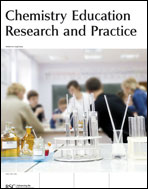Semantic mistakes and didactic difficulties in teaching the “amount of substance” concept: a useful model
Abstract
Textbooks still have the distinction of being the most dominant teaching tool in science teaching. The manner in which a scientific concept is expressed in a textbook is of importance in the in-depth learning process of that concept. With this in mind, problems with expressing the “amount of substance” concept were reviewed in 15 chemistry textbooks published in three different countries (United States, France and Turkey). The problems were analyzed in terms of semantic and didactic perspectives. It was found that the semantic mistakes in the presentation of the amount of substance concept in chemistry textbooks stemmed from: (i) missing concepts, (ii) the use of knowledge at the incorrect level, (iii) the use of the term “number of moles”, (iv) limitations in meaning resulting from a lower concept being used in place of a higher concept, and (v) the use of the amount of substance concept as equivalent to mass, Avogadro’s constant, molar volume and molar mass. Additionally, difficulties were observed that arose from the inappropriate didactic transposition of textbook subjects. These didactic difficulties stemmed from associating the amount of substance with more than one physical quantity. Teaching models for meaningfully teaching the amount of substance at the macroscopic, microscopic and symbolic levels of chemistry have been suggested and discussed.

 Please wait while we load your content...
Please wait while we load your content...